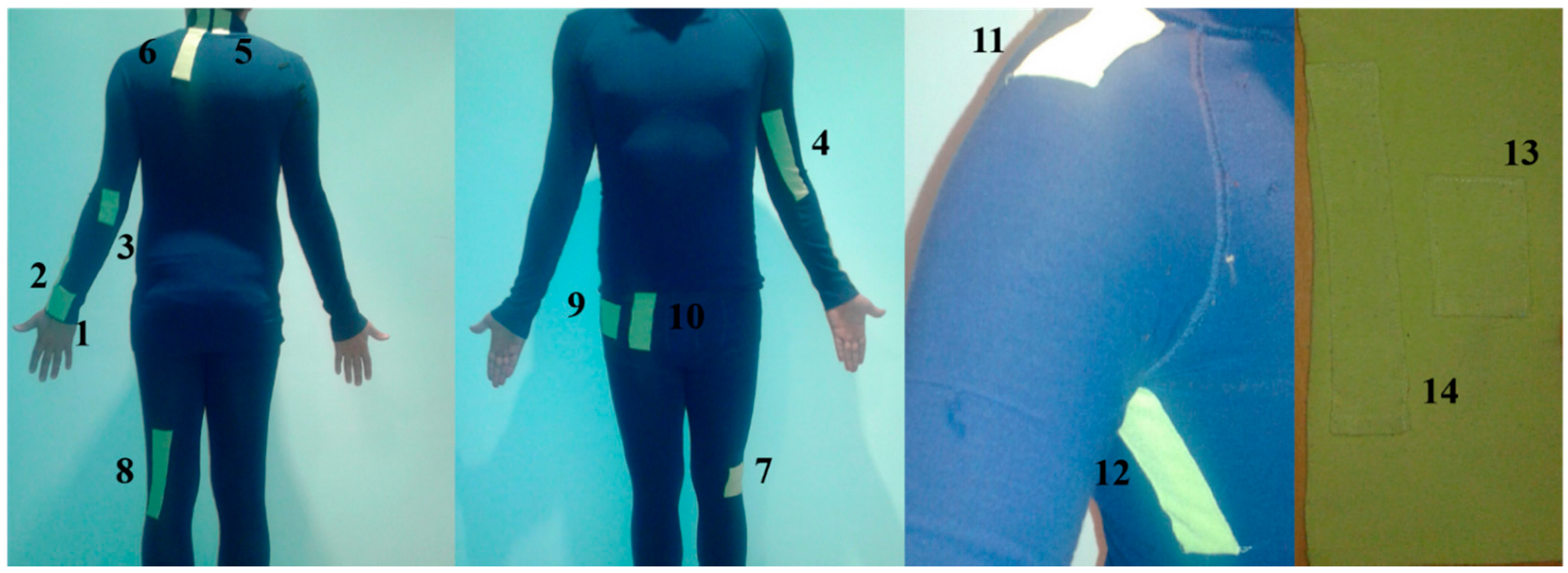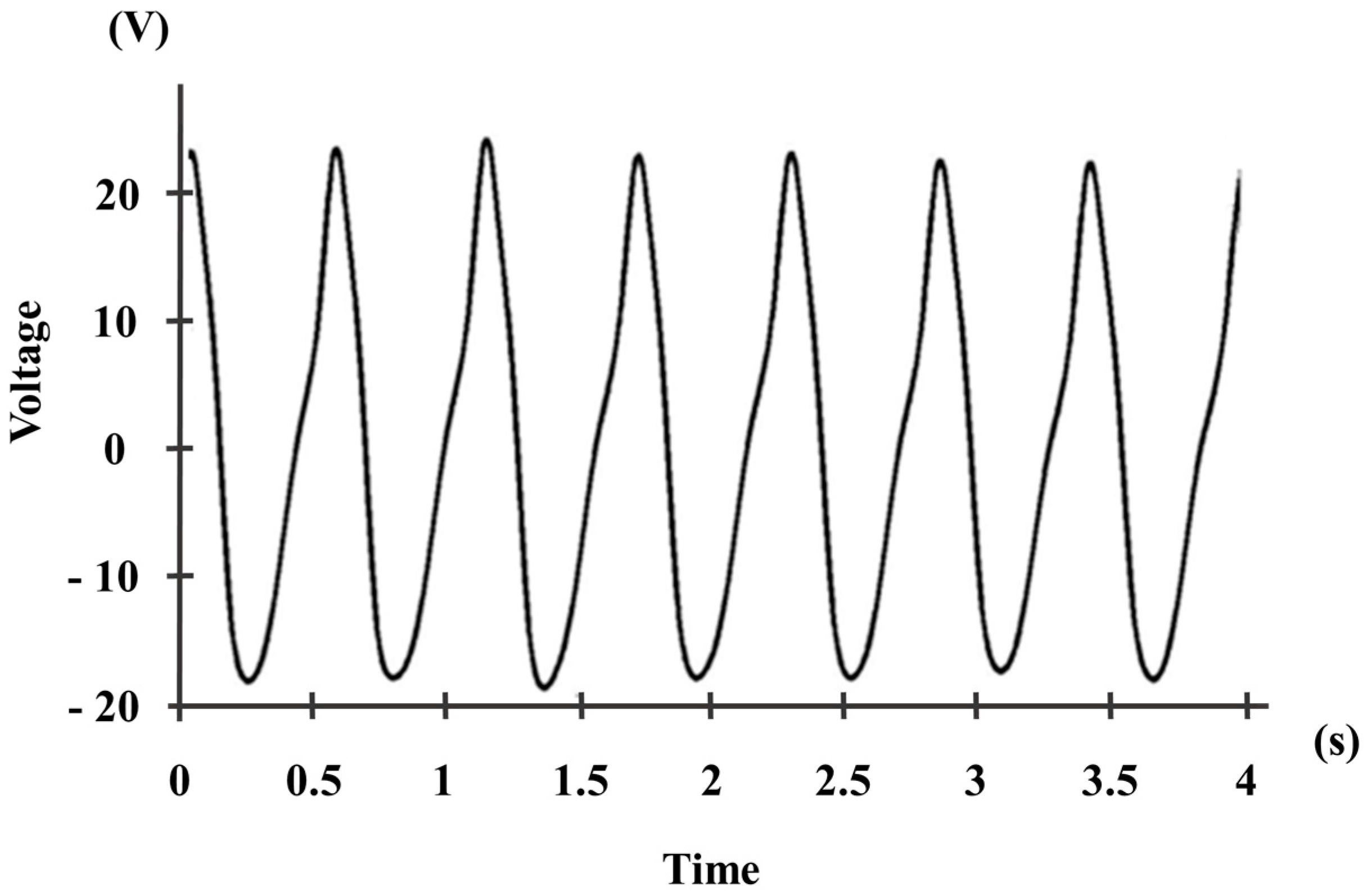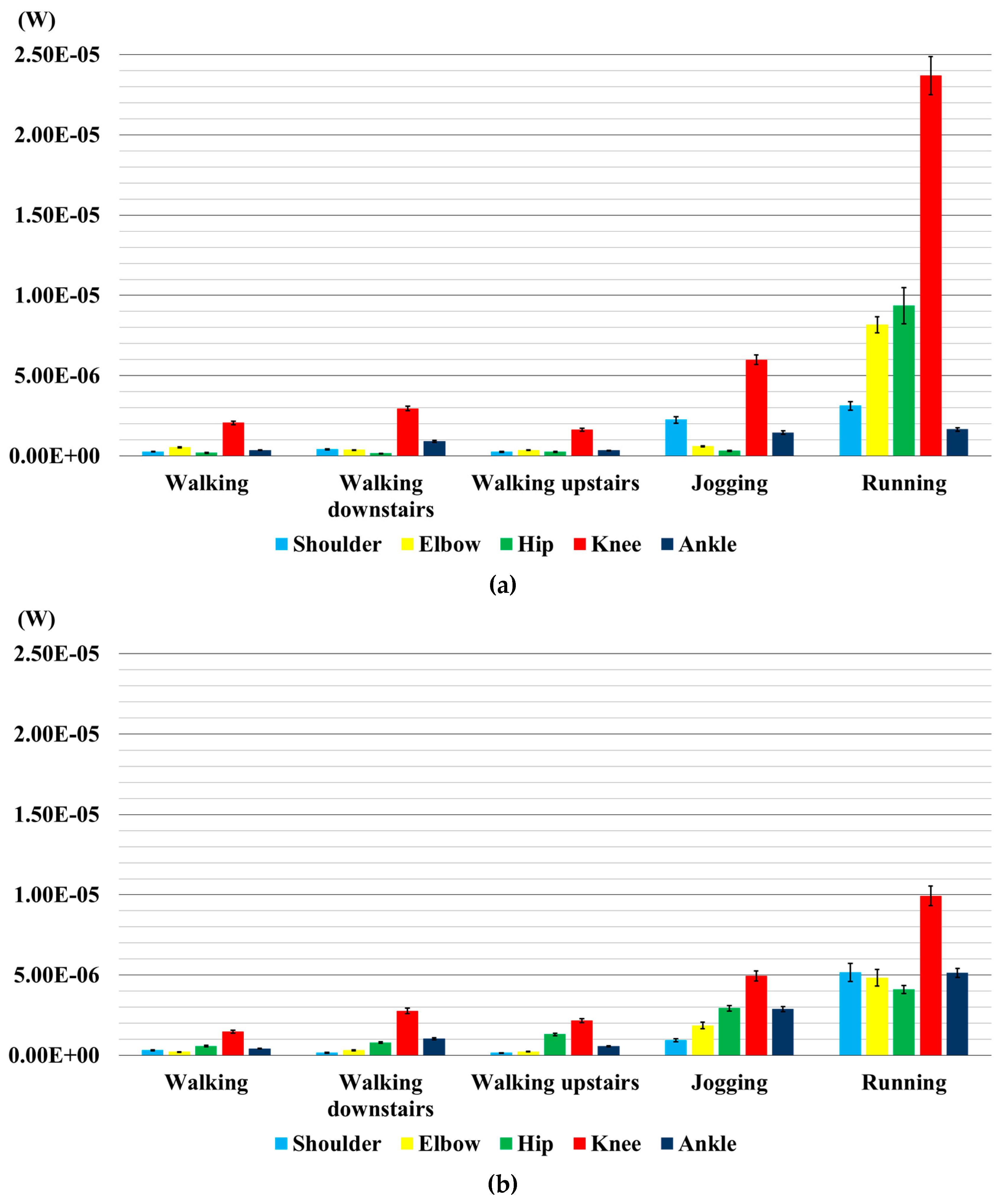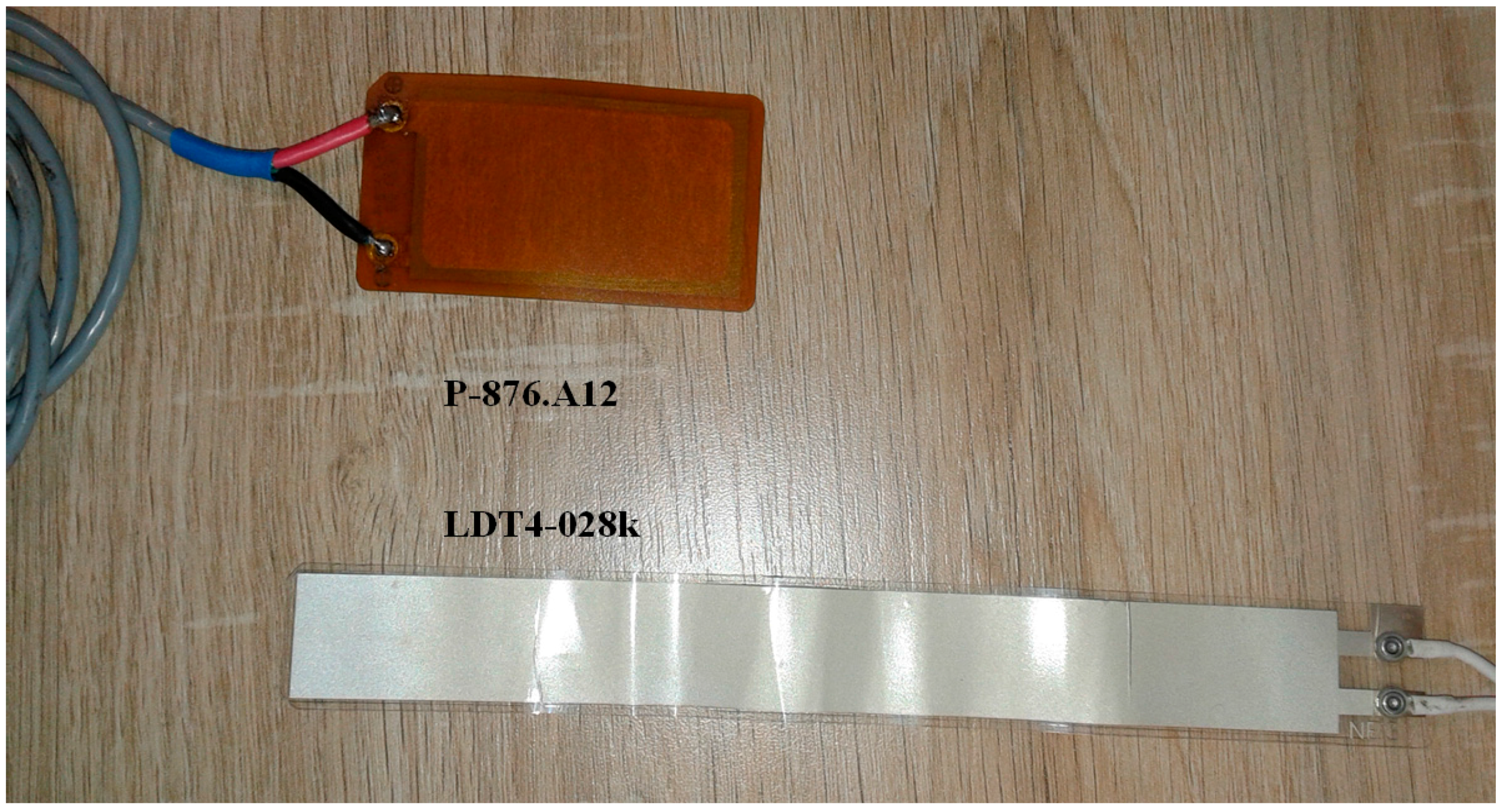4.1. Preliminary Measurements
To find out the voltage output, the following measurement circuit (
Figure 3) was used, and the values of the voltage output were measured and acquired by the NI USB-6210 data acquisition system (DAQ), National Instruments. A voltage divider circuit was used as the input stage of the NI USB-6210 DAQ in order to avoid the problem of saturation given by the range of voltage values at the input stage of the DAQ.
The voltage output for the circuit in
Figure 3 is given by the following Equation (4) [
32]:
The power values, based on a fixed value of the resistive load, were calculated. In order to optimize the power output, the ranges of fixed values of the resistors were carefully chosen based on the transducers datasheets [
33,
34] and on the motion frequency of the joint movements, so that the following relation is achieved:
The range values of the resistor loads are shown in
Table 5.
To ensure that the P-876.A12 transducer could be bent properly, perfectly following the whole movement of the joints, it was necessary to place an extra elastic band over the suit, to make the transducers adhere to the body part during movement. Conversely, the LDT4-028k transducers did not need any additional support to secure their placement, due to their higher flexibility and ability to follow the joint movements.
To obtain the root mean square values of the voltages, currents and powers, the measured values of the peak-to-peak voltage output were used in the following Equation (6).
Equation (6) was used to find the RMS values from each performed movement repetition, shown in
Table 2. In the case of these movements, the nature of the angular movements could be roughly approximated to Equation (6), even if it deviates from a pure sinusoidal tone, as it is shown in
Figure 4.
Three healthy male volunteers (age: 34 ± 5 years; body weight: 76 ± 4 kg; height: 175 ± 5 cm) were recruited to perform the joint movements listed in
Table 2. Each joint movement was repeated five times, and the measuring time for each test was around ten seconds.
Figure 5 shows output RMS power values coming from the body joints for each value of the resistive load. Both transducers produce a signal output proportional to the folding movement and frequency of the performed test. To obtain the maximum value of the power output, the most important parameter is the proper positioning of the transducer on the suit close to the skin, so that it can be bent as much as possible. The inherent different nature of the transducers makes it difficult to use the same exact location for both sensors, since the rigidity of the P-876.A12 transducer makes it necessary to provide the user with a sustaining structure and a different placement as compared to the LDT4-028k transducer. This consideration makes it impossible to directly compare the power output of transducers, but since the focus of the work is on the applicability of the transducers in real-life conditions, the comparison between transducers needs to include the positioning choice, as well.
In the P-876.A12 transducer diagram (
Figure 5a), the power outputs for the elbow joint are higher than those obtained for the other joints. In the graph of the LDT4-028k transducer (
Figure 5b), the highest power output values are those related to wrist, knee and hip joints. For both transducers, the values of the power output increase with the increase of R
load to reach a maximum value, and then, they gradually decrease. Comparing the graphs in
Figure 5a,b, the maximum values of the power output for P-876.A12 on the elbow (49.1 µW), ankle (4.94 µW), wrist (22.2 µW) and neck (7.68 µW) joints are higher than those obtained by LDT4-028k on the same joints. Conversely, the maximum values of the power output for LDT4-028k on the shoulder (12.3 µW), knee (15.9 µW) and hip (15.0 µW) joints are higher than those appearing for P-876.A12 placed on the same joints.
4.2. Measurements of the Power Output during Locomotion Activities
Five common activities were chosen to test the two piezoelectric transducers. The common activities were walking, walking down and up the stairs, jogging and running, and the chosen joints for the tests were the shoulder, elbow, hip, knee and ankle. For each activity, voltages were measured and acquired by the NI USB-6210 DAQ, National Instruments, while current and power values, based on a fixed value of the resistive load, were calculated using MATLAB software. A voltage divider circuit was used as the input stage of the NI USB-6210 DAQ to avoid saturation given by the range of voltage values at the input stage of the DAQ. The fixed values of the resistive load, based on the previous measurements (
Figure 5), were carefully chosen for each joint, and they are shown in
Table 6. These values were obtained through interpolation and approximation of the discrete values tested in the first experimentation.
The tests were repeated for each reported resistance value, and thus, the values of the power output were obtained in statistical terms as average values across multiple repetitions, to take into account the inherent variability of having different participant population samples repeating the mentioned activities.
Three healthy male volunteers (age: 34 ± 5 year; body weight: 76 ± 4 kg; height: 175 ± 5 cm) were recruited to perform the activities listed in
Table 3. Each task was repeated four times. The measuring time of walking and walking down and up the stairs was one minute for each test, while the measuring time of the jogging activity was twenty seconds and for the running activity eight seconds.
Also for these tests, the inherent different nature of the transducers makes it difficult to use the same exact location for both sensors, since the rigidity of the P-876.A12 transducer makes it necessary to provide the user with a sustaining structure and a different placement as compared to the LDT4-028k transducer.
Figure 6 shows the measurements of the RMS power output values of the body joints, for each performed activity. Locomotion activities, such as walking and walking up stairs, produce the lowest values of the power output for both transducers, while running produces the highest values for both of them, followed by power output values of jogging and walking down stairs.
As it can be clearly seen in
Figure 6a, walking, walking up stairs and walking down stairs, for P-876.A12, led to very similar power output. Out of these three activities, the knee joint produces the highest values of power output (2.21 µW) followed by the ankle (0.54 µW), elbow (0.41 µW), shoulder (0.31 µW) and hip (0.20 µW) joints. As for the jogging activity, the knee joint produces the highest value of power output (5.98 µW) followed by the shoulder (2.24 µW), ankle (1.45 µW), elbow (0.60 µW) and hip (0.31 µW) joints. As for running, the knee joint produces the highest value of the power output (23.70 µW) followed by hip (9.37 µW), elbow (8.16 µW), shoulder (3.12 µW) and ankle (1.65 µW) joints.
Similar considerations apply to the LDT4-028k transducer (
Figure 6b), though with lower absolute values. In all activities, except running and jogging, the knee joint produces the highest value of power output (1.90 µW) followed by the hip (0.95 µW), ankle (0.67 µW), elbow (0.25 µW) and shoulder (0.21 µW) joints. As for jogging, the knee joint produces the highest value of power output (3.71 µW) followed by the ankle (2.88 µW), hip (2.43 µW), elbow (1.86 µW) and shoulder (4.46 µW) joints. As for running, the knee joint produces the highest value of power output (8.83 µW) followed by the shoulder (5.16 µW), ankle (5.13 µW), elbow (4.83 µW) and hip (4.46 µW) joints.
Table 7 breaks down the comparison between P-876.A12 (PZT) and LDT4-028k (PVDF) considering all the locomotion activities and all the joints, highlighting which transducer performed best for each activity and joint.
During walking, the values of the power output measured at each joint were very similar for both transducers: elbow (+0.31 µW) and knee (+0.47 µW) joints provide better results with P-876.A12, while the hip joint (+0.66 µW) is better with LDT4-028k.
Similar considerations apply to the case of walking down stairs, with slightly better results on the shoulder joint (+0.26 µW) for P-876.A12 and better on the hip joint (+0.52 µW) for LDT4-028k.
In the case of walking up stairs, LDT4-028k provides clearly better results than P-876.A12 at the hip joint (+1.08 µW). As for the jogging activity, P-876.A12 provides better results both at the shoulder (+1.30 µW) and at the knee (+2.27 µW) joints, while LDT4-028k resulted in being better for the elbow (+1.26 µW), hip (+2.12 µW) and ankle (+1.43 µW) joints. Finally, in the case of running, P-876.A12 performed better than LDT4-028k at the elbow (+3.33 µW), hip (+4.91 µW) and knee (+14.87 µW) joints, while the opposite applies to the shoulder (−2.04 µW) and ankle (−3.48 µW) joints.
The graph in
Figure 7 shows the results of the overall comparison between the transducers, by considering the sum of the power output values measured at each joint for each locomotion activity. From the overall comparison, transducers are similar in terms of power generation for both walking and walking down stairs; when walking upstairs and jogging, LDT4-028k is more efficient than P-876.A12. Finally, during running, even if both transducers are appropriate for use as energy harvesters, the PZT transducer performed better than PVDF. The numerical values are summarized in
Table 8.
Table 9 breaks down the power generated by the ones that come from the upper body joints and the ones coming from the lower limb joints. The power contribution from the upper body joints is almost negligible for the three walking activities, while it can be considered as a significant source of power generation for both jogging and running.













